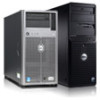Dell PowerEdge M520 Technical Guide - Page 5
System Overview
 |
View all Dell PowerEdge M520 manuals
Add to My Manuals
Save this manual to your list of manuals |
Page 5 highlights
1 System Overview Introduction Enjoy excellent performance and exceptional value with the Dell™ PowerEdge™ M520 system's well-balanced processing capabilities and memory capacity in a compact half-height blade form factor. With up to 16 processor cores and up to 12 DIMMs of RAM, the scalability and performance of the M520 makes it a natural fit for general business applications such as email and databases, as well as mid-tier virtual environments. Achieve business continuity Ensure maximum uptime with the fully redundant M-series power, cooling and networking infrastructure, designed to provide the stability and resiliency our customers demand for enterprise-class deployments. The M520 system's design matches Dell's commitment to reliability, with features such as multiple hardware RAID choices and our unique failsafe virtualization technology, which uses redundant SD media to provide failover capabilities for embedded hypervisors. Simplified systems management, without compromise The Dell OpenManage™ systems management portfolio, includes Integrated Dell Remote Access Controller 7 (iDRAC7) with Lifecycle Controller. This embedded feature helps IT administrators manage Dell servers in physical, virtual, local and remote environments, operating in-band or out-of-band, with or without a systems management software agent installed. OpenManage iDRAC with Lifecycle Controller integrates and connects to leading third-party systems management solutions (such as those from Microsoft, VMware, and BMC Software), so users can maintain a single point of control and capitalize on an existing systems management investment. OpenManage simplifies the lifecycle of deploying, updating, monitoring and maintaining your Dell PowerEdge servers. The PowerEdge M-series blade server line Implement the right combination of features and performance scalability with the PowerEdge M-series blade servers, which can handle tough workloads in a data center of any size. In addition to the world-class management features provided in all PowerEdge servers, the M520 also takes advantage of the capabilities of the Dell PowerEdge M1000e's Chassis Management Controller (CMC). The CMC allows M-series blades to be managed individually or as groups, in single or multiple chassis, and within a data center or in multiple geographically dispersed locations around the globe without requiring a single agent or additional hardware. PowerEdge M-series blade servers use the redundant power, cooling and networking infrastructure provided by the M1000e blade enclosure, which is exceptionally easy to deploy and manage and maximizes power and cooling efficiency. 5 PowerEdge M520 Technical Guide














